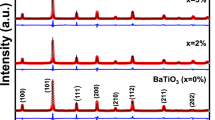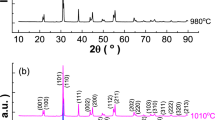Abstract
We introduce a modified sintering approach to investigate the microstructure, dielectric, and resistive switching (RS) properties of bulk Ba0.7Sr0.3TiO3 (BST) ceramics. The ceramics were prepared using a solid-state-reaction method, and then sintered using modified double-step sintering (DS) processes, as well as conventional single-step sintering (CSS) at different peak temperatures (1250°C and 1350°C). To find the phase purity, lattice parameters, and tetragonality of the samples, x-ray diffraction patterns were fitted with the pseudo-Voigt function in the FullProf software. With the help of the software, bond angles and bond lengths were found for all the ceramics. Furthermore, Raman spectrum analysis was performed to confirm the samples' structural variations. The microstructure images of the samples show that the grain size was reduced and the grain size distribution was improved for the DS-processed ceramics as compared to the CSS-processed ceramics. The dielectric properties of the BST ceramic capacitors were investigated in a wide range of frequencies and temperatures. All the BST ceramics displayed humps at near-room temperature, corresponding to tetragonal–cubic phase transitions, and a small shift in transition temperature towards higher temperature regions for the DS ceramics compared with the CSS ceramics was observed due to structural modification by a grain size effect. The metal–insulator–metal (MIM) structures, so-called memristors, were designed with these dielectric ceramics. A bipolar RS behavior was observed in these MIM structures which were confirmed through current–voltage (I–V) characteristics. The improved RS in these structures is the result of the migration and redistribution of cations, such as oxygen ions and oxygen vacancies ,as well as the ferroelectric domain orientation.








Similar content being viewed by others
References
G. Zhou, Z. Wang, F. Bai Sun, L. Zhou, H. Sun, X. Zhao, X. Hu, J. Peng, H. Yan, W. Wang, J. Wang, B. Li, D. Yan, Y. Kuang, L. Wang, and S.D. Wang, Volatile and nonvolatile memristive devices for neuromorphic computing. Adv. Electron. Mater. 8, 2101127 (2022).
S. Kaeriyama, T. Sakamoto, H. Sunamura, M. Mizuno, H. Kawaura, T. Hasegawa, K. Terabe, T. Nakayama, and M. Aono, A nonvolatile programmable solid-electrolyte nanometer switch. IEEE J. Solid-State Circuits 40, 168 (2005).
A.A. Minnekhanov, A.V. Emelyanov, D.A. Lapkin, K.E. Nikiruy, B.S. Shvetsov, A.A. Nesmelov, V.V. Rylkov, V.A. Demin, and V.V. Erokhin, Parylene based memristive devices with multilevel resistive switching for neuromorphic applications. Sci. Rep. 9, 10800 (2019).
Z. Wang, L. Wang, M. Nagai, L. Xie, M. Yi, and W. Huang, Nanoionics-enabled memristive devices: strategies and materials for neuromorphic applications. Adv. Electron. Mater. 3, 1600510 (2017).
V. Gupta, S. Kapur, S. Saurabh, and A. Grover, Resistive random Access memory: a review of device challenges. IETE Tech. Rev. 37, 377 (2020).
Z. Fan, L. Li, X. Mei, F. Zhao, H. Li, X. Zhuo, X. Zhang, Y. Lu, L. Zhang, and M. Liu, Multilayer ceramic film capacitors for high-performance energy storage: progress and outlook. J. Mater. Chem. A 9, 9462 (2021).
T. Zheng, J. Wu, D. Xiao, and J. Zhu, Recent development in lead-free perovskite piezoelectric bulk materials. Prog. Mater. Sci. 98, 552 (2018).
A.R. Jayakrishnan, P.V.K. Yadav, J.P.B. Silva, and K.C. Sekhar, Microstructure tailoring for enhancing the energy storage performance of 0.98[0.6Ba(Zr0.2Ti0.8)O3-0.4(Ba0.7Ca0.3)TiO3]-0.02BiZn1/2Ti1/2O3 Ceramic Capacitors. J.Sci.: Adv. Mater. Devices 5, 119–124 (2020). https://doi.org/10.1016/j.jsamd.2019.12.001.
M. Zhou, R. Liang, Z. Zhou, and X. Dong, Novel BaTiO3-based lead-Free ceramic capacitors featuring high energy storage density, high power density, and excellent stability. J. Mater. Chem. C 6, 8528 (2018).
H. Yang, C. Zhou, X. Liu, Q. Zhou, G. Chen, H. Wang, and W. Li, Structural, microstructural and electrical properties of BiFeO3–BaTiO3 ceramics with high thermal stability. Mater. Res. Bull. 47, 4233 (2012).
E. Salernitano, S. Grilli, F. Mazzanti, P. Fabbri, and G. Magnani, Definition of the parameters for the densification of ceramics by two-step solid state sintering. Open Ceram. 9, 100242 (2022).
Y. Dong, H. Yang, L. Zhang, X. Li, D. Ding, X. Wang, J. Li, J. Li, and I.-W. Chen, Ultra-uniform nanocrystalline materials via two-step sintering. Adv. Funct. Mater. 31, 2007750 (2021).
I.-W. Chen, and X.-H. Wang, Sintering dense nanocrystalline ceramics without final-stage grain growth. Nature 404, 168 (2000).
H.T. Kim, and Y.H. Han, Sintering of nanocrystalline BaTiO3. Ceram. Int. 30, 1719 (2004).
G.H. Haertling, Ferroelectric ceramics: history and technology. J. Am. Ceram. Soc. 82, 797 (1999).
J.A. Dawson, D.C. Sinclair, J.H. Harding, and C.L. Freeman, A-site strain and displacement in Ba1–xCaxTiO3 and Ba1–xSrxTiO3 and the consequences for the curie temperature. Chem. Mater. 26, 6104 (2014).
S. Balmuchu, and P. Dobbidi, Temperature-dependent broadband Dielectric and Ferroelectric Properties of Ba(1-x)SrxTiO3 Ceramics for Energy Storage Capacitor Applications. J. Mater. Sci. Mater. Electron. 32, 9623 (2021).
V. Annapu Reddy, N.P. Pathak, and R. Nath, Particle size dependent magnetic properties and phase transitions in multiferroic BiFeO3 nano-particles. J. Alloys Compd. 543, 206 (2012).
A.R. Jayakrishnan, P.V.K. Yadav, J.P.B. Silva, and K.C. Sekhar, Microstructure tailoring for enhancing the energy storage performance of 0.98[0.6Ba(Zr0.2Ti0.8)O3-0.4(Ba0.7Ca0.3)TiO3]-0.02BiZn1/2Ti1/2O3 ceramic capacitors. J. Sci.: Adv. Mater. Devices 5, 119–124 (2019). https://doi.org/10.1016/j.jsamd.2019.12.001.
M.K. Shamim, S. Sharma, A. Singh, R. Rai, and R. Rani, Study of the structural and electrical behavior of Bi(Mg, Ti)O3 modified (Ba, Ca)TiO3 ceramics. J. Adv. Dielectr. 06, 1650035 (2016).
A. Dixit, S.B. Majumder, P.S. Dobal, R.S. Katiyar, and A.S. Bhalla, Phase transition studies of sol-gel deposited barium zirconate titanate thin films. Thin Solid Films 447–448, 284 (2004).
V.P. Pavlovic, M.V. Nikolic, V.B. Pavlovic, J. Blanusa, S. Stevanovic, V.V. Mitic, M. Scepanovic, and B. Vlahovic, Raman responses in mechanically activated BaTiO3. J. Am. Ceram. Soc. 97, 601 (2014).
Z. Yao, H. Liu, Y. Liu, Z. Wu, Z. Shen, Y. Liu, and M. Cao, Structure and dielectric behavior of Nd-doped BaTiO3 perovskites. Mater. Chem. Phys. 109, 475 (2008).
P.R. Bueno, R. Tararan, R. Parra, E. Joanni, M.A. Ramirez, W.C. Ribeiro, E. Longo, and J. Varela, A polaronic stacking fault defect model for CaCu3Ti4O12 material: an approach for the origin of the huge dielectric constant and semiconducting coexistent features. J. Phys. D Appl. Phys. 42, 055404 (2009).
L. Nedelcu, A. Ioachim, M. Toacsan, M.G. Banciu, I. Pasuk, C. Berbecaru, and H.V. Alexandru, Synthesis and dielectric characterization of Ba0.6Sr0.4TiO3 ferroelectric ceramics. Thin Solid Films 519, 5811–5815 (2011). https://doi.org/10.1016/j.tsf.2010.12.191.
Z. Zhao, V. Buscaglia, M. Viviani, M.T. Buscaglia, L. Mitoseriu, A. Testino, M. Nygren, M. Johnsson, and P. Nanni, Grain-size effects on the ferroelectric behavior of dense nanocrystalline BaTiO3 ceramics. Phys. Rev. B 70, 24107 (2004).
X.-H. Wang, I.-W. Chen, X.-Y. Deng, Y.-D. Wang, and L.-T. Li, New progress in development of ferroelectric and piezoelectric nanoceramics. J. Adv. Ceram. 4, 1 (2015).
L. Wu, Z. Cai, C. Zhu, P. Feng, L. Li, and X. Wang, Significantly enhanced dielectric breakdown strength of ferroelectric energy-storage ceramics via grain size uniformity control: phase-field simulation and experimental realization. Appl. Phys. Lett. 117, 212902 (2020).
D. Damjanovic, Piezoelectric response and free-energy instability in the perovskite crystals BaTiO3, PbTiO3, and Pb(Zr, Ti)O3. Phys. Rev. B 73, 174106 (2006).
Y. Yang and W. Lu, Nanoscale resistive switching devices: mechanisms and modeling. Nanoscale 5, 10076 (2013).
R. Waser, R. Dittmann, G. Staikov, and K. Szot, Redox-based resistive switching memories – nanoionic mechanisms, prospects, and challenges. Adv. Mater. 21, 2632 (2009).
C. Singh, V.N. Thakur, and A. Kumar, Polarization controlled resistive switching in bulk ferroelectric ceramics: a universal phenomenon. J. Alloys Compd. 887, 161345 (2021).
Y. Yang, P. Sheridan, and W. Lu, Complementary resistive switching in tantalum oxide-based resistive memory devices. Appl. Phys. Lett. 100, 203112 (2012).
Acknowledgments
The author, KC, acknowledges the financial support provided by NIT Tiruchirappalli, and the Ministry of Human Resources and Development (MHRD), India. AV would like to acknowledge the support from the Department of Science and Technology (DST), Government of India under the INSPIRE Faculty scheme (Grant No. DST/INSPIRE/04/2016/001295), and Science and Engineering Research Board (SERB), Government of India under Start-up Research Grant (Grant No. SERB/F/7249/2019-2020).
Author information
Authors and Affiliations
Corresponding author
Ethics declarations
Conflict of Interest
The authors declare that they have no conflict of interest.
Additional information
Publisher's Note
Springer Nature remains neutral with regard to jurisdictional claims in published maps and institutional affiliations.
Rights and permissions
Springer Nature or its licensor (e.g. a society or other partner) holds exclusive rights to this article under a publishing agreement with the author(s) or other rightsholder(s); author self-archiving of the accepted manuscript version of this article is solely governed by the terms of such publishing agreement and applicable law.
About this article
Cite this article
Kaushiga, C., Kaarthik, J., Sradha, G. et al. Influence of Sintering Temperature Strategy on Structural, Dielectric, and Resistive Switching in Bulk Ba0.7Sr0.3TiO3 Ceramics. J. Electron. Mater. 52, 1691–1699 (2023). https://doi.org/10.1007/s11664-022-10119-6
Received:
Accepted:
Published:
Issue Date:
DOI: https://doi.org/10.1007/s11664-022-10119-6




